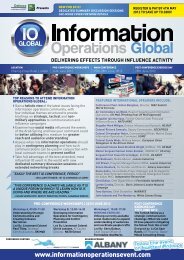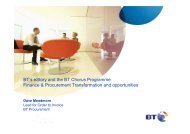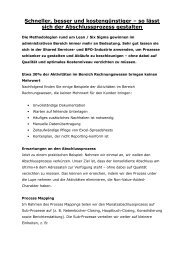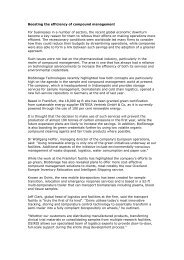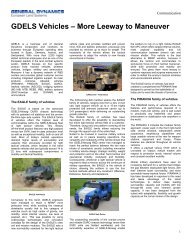What is “Lean” HR Service - IQPC.com
What is “Lean” HR Service - IQPC.com
What is “Lean” HR Service - IQPC.com
Create successful ePaper yourself
Turn your PDF publications into a flip-book with our unique Google optimized e-Paper software.
<strong>What</strong> <strong>is</strong> <strong>“Lean”</strong> <strong>HR</strong> <strong>Service</strong>?<br />
When it <strong>com</strong>es to “lean” there <strong>is</strong> no better place to start than GE, where lean got its<br />
name.<br />
SSON recently spoke with Stephen Brown, who in h<strong>is</strong> previous role as head of global<br />
talent acqu<strong>is</strong>ition at GE Healthcare, pushed “lean” across all aspects of the<br />
recruitment process. Having started on the operational side, as a client of recruitment<br />
services, Stephen knows only too well how quickly a bottleneck <strong>is</strong> translated to “bad<br />
service” – and what it costs the operation in terms of time lost. Today, at GE<br />
Healthcare, the recruitment team and its in-house clients work in a strong partnership<br />
and continuous improvement has be<strong>com</strong>e a daily mantra. RPO has be<strong>com</strong>e a strong<br />
element of the lean process at GE healthcare. KellyOCG has be<strong>com</strong>e a long-time<br />
trusted partner in GE Healthcare‟s lean <strong>HR</strong> services strategy.<br />
SSON interview with Steven Brown, Sr. Human Resources Manager, CT & AW - GE<br />
Healthcare<br />
Recruitment process outsourcing <strong>is</strong> increasingly making headlines as corporations<br />
seek the flexibility of scale it offers, as well as the expert<strong>is</strong>e of special<strong>is</strong>t recruiters.<br />
We ask Steven Brown, previously Global Talent Acqu<strong>is</strong>ition Leader for GE healthcare,<br />
how RPO supports GE Healthcare’s <strong>com</strong>petitive edge.<br />
BH: Steven, could you please start out by explaining how the RPO partnership<br />
between KellyOCG and GE Healthcare came about?<br />
SB: The partnership between Kelly and GE goes back about 11 years. But the<br />
partnership specifically between Kelly and GE Healthcare, around Lean, really started<br />
in 2006. At that point, my predecessor was really looking for opportunities to improve<br />
overall customer service and customer delivery of the staffing process. That's when<br />
Kelly and GE Healthcare really sat down and did -- in GE terms -- a workout,<br />
meaning, taking a look at all the processes and trying to evaluate how we could<br />
improve on them.<br />
And so they looked at key metrics with regards to cycle time. They looked at key<br />
services with regards to overall customer sat<strong>is</strong>faction. Now the interesting thing was<br />
that previously, we didn't look at Lean to be applied to staffing, even though we had<br />
used it elsewhere around GE Healthcare. GE has, as you know, a strong h<strong>is</strong>tory in Six<br />
Sigma, and Lean was really adopted for our manufacturing workforce.<br />
But we thought there were elements, in regards to workflow, bottleneck, time to<br />
delivery, etc., in some of those processes, where Lean thinking could be applied.<br />
I was actually an <strong>HR</strong> manager at the time, and so I was a customer of th<strong>is</strong> staffing<br />
process. About a year and a half later <strong>is</strong> when I actually joined the staffing team as a<br />
1
US staffing leader, and continued a lot of the methodology. But as most of my <strong>HR</strong><br />
background has been tied into operations, I certainly got what Lean process was all<br />
about.<br />
Part of the challenge, when you adopt a Lean process, <strong>is</strong> not just the implementation<br />
but continuous improvement around that. You can't just put Lean in and just say, well,<br />
I'm done. You need to continue to l<strong>is</strong>ten to what the customers are saying, continue to<br />
look at your key process indicators, and continuously evaluate: where can we<br />
eliminate waste? And in our case, eliminating „waste‟ meant eliminating the delays,<br />
the bottlenecks in the process. And so I went from customer to supplier, and really,<br />
over the three years that we‟ve been doing th<strong>is</strong>, we went from being just US-based, to<br />
applying some of these concepts globally.<br />
BH: And does your team run these processes globally?<br />
SB: Well, yes. Having started as US staffing leader, I then took on the responsibility<br />
of global staffing leader. And so a lot of the conversation, the methodology, the<br />
principles, … while not fully adopted globally, were nevertheless easily applied,<br />
because much of th<strong>is</strong> thinking <strong>is</strong> just best practices, right?<br />
BH: Of course.<br />
SB: So, if you look at them as best practices, then you can share them. Maybe not the<br />
entire value stream map, because each of those really needs to be adopted locally. But<br />
at least the methodology and the best pract<strong>is</strong>es were starting to move beyond the US.<br />
BH: When you were a customer, Steven, what were your biggest <strong>com</strong>plaints? And<br />
how did you feel, as a customer, that the changes being instituted with Lean were<br />
improving your experience?<br />
SB: That's a great question. As a customer, I always thought that the staffing function<br />
should have candidates waiting for me -- because they should read my mind, right!?<br />
So they should know when I had an opening forth<strong>com</strong>ing and needed candidates. I<br />
think when they started introducing some of the changes in staffing, one of the things<br />
that really helped was that they share, with all <strong>HR</strong> managers, the target date and the<br />
target cycle time – which <strong>is</strong> approximately 60 days. And within these 60 days, they<br />
share the breakdown of when things should happen. In fact, not only when things<br />
should happen, but also who had ownership during the sub-cycle processes. I think<br />
previously, th<strong>is</strong> was probably a bit of a mystery.<br />
Again, as a customer, I thought: why couldn't they just have a slate of candidates<br />
waiting? But when they laid out the process -- for example, between days 1-3, you<br />
host a job launch -- well, what that meant was that I had to actively work with staffing<br />
to talk about that job. And days 3-10, they would begin sourcing candidates. And then<br />
by day 15, they would send me candidates. And then I had to provide them with<br />
feedback. Etc.<br />
So it was a really nice way of laying out the ownership and the process. I have to say<br />
2
that was the first time the process made sense to me. And it highlighted the<br />
partnership that needs to happen. And part of that partnership <strong>is</strong> knowing how to<br />
continue to improve it.<br />
BH: So, now you've got th<strong>is</strong> new process, how do you build continuous improvement<br />
into it? <strong>What</strong> I mean <strong>is</strong>, how do you get the client to engage – because Lean requires<br />
both sides‟ inputs, right?<br />
SB: Yes, so part of the conversation during the job launch <strong>is</strong>, here's your role and<br />
here's my role. We agree to have regular meetings to make sure we're flowing along.<br />
So you put those operating mechan<strong>is</strong>ms in early within the process and you can then<br />
check if there <strong>is</strong> a kink in your process. For example, have you changed the profile of<br />
the candidate? And if you have, let's stop and look at where we are, where we need to<br />
go … because now you have changed something within the system. Again, going<br />
back to my operational days, you literally have to step back and look at the whole<br />
process as separate „points‟. You don't go all the way to the end and say, I guess it<br />
didn't work. Frankly, when you look at Lean and continuous improvement, it <strong>is</strong><br />
<strong>com</strong>mon sense. It‟s about saying: what <strong>is</strong> the best way for delivery? <strong>What</strong> do you need<br />
in place in order to get a better result?<br />
BH: <strong>What</strong> were some of the hurdles? I imagine you experienced a certain amount of<br />
push-back?<br />
SB: Sure. The client just wants the end-result. And suddenly you‟re asking him to get<br />
more involved? The way that we manage th<strong>is</strong> conversation -- and, again, it's an<br />
ongoing conversation -- <strong>is</strong> that we have to look at bringing on talent as an investment,<br />
same as you look at capital equipment. The more that you can get people to<br />
understand, and the more they're involved, the better the output will be. Not that we're<br />
asking them to do the job, but we're asking for their partnership.<br />
Initially, the reaction was predictable: L<strong>is</strong>ten, you're the staffing professional, I just<br />
want to get to the end result, and I want the product to be fantastic. Once people<br />
started seeing the results, it not only improved cycle time, but it also improved<br />
diversity metric (women and people of color) . Being a customer doesn't exempt you<br />
from being involved with the process. In fact, it should encourage you to be involved<br />
with the process, because you have to live with the result.<br />
BH: When you were responsible for the global talent management, how were you in<br />
effect benefiting GE Healthcare? How were you making a difference?<br />
SB: Ultimately, when you look at a staffing process that works well, in essence, you<br />
have reduced the amount of time in a vacancy. So, if you are able to engage your<br />
management team, your hiring managers, early, then you're able to fill those jobs in a<br />
very smart, timely way. Therefore, the productivity of the team and the enhancement<br />
of the talent you're bringing in has a direct impact on the bottom line.<br />
We only use Kelly for our US team. Outside the US, Kelly <strong>is</strong> not our RPO provider.<br />
And yet the principles that we establ<strong>is</strong>hed in the US with Kelly have been elements<br />
that we've started to use much more broadly, outside of the US.<br />
3
BH: So, given everything else you've explained, why outsource the recruiting<br />
function? How does that fit in with the Lean strategy, the Lean idea?<br />
SB: I would have to separate those two ideas. We already had the RPO relationship<br />
before we moved to Lean. So, what the RPO allows us to do, really, <strong>is</strong> twofold. One, it<br />
allows us some scalability. So, as our volume, our hiring volume, changes up and<br />
down, it allows us to either add or take resources off the program, so we're able to<br />
continue to meet the overall customer needs.<br />
The second piece <strong>is</strong> that, when we look at the <strong>com</strong>petencies related to being a<br />
recruiter, we had to decide: did we want to build that <strong>com</strong>petency in-house, or did we<br />
want to buy that <strong>com</strong>petency? And the conversation it really led to was: if you want to<br />
be really good, ie, have a really strong recruiting model, then we should probably<br />
have people who want to be recruiters doing the work, as opposed to an in-house<br />
model, where you may end up having two challenges: One <strong>is</strong>, you have recruiters who<br />
really want to be <strong>HR</strong> managers, but recruiting <strong>is</strong> their stepping stone into being an <strong>HR</strong><br />
manager. Or the second challenge: you have recruiters who you may not be able to<br />
grow and stretch, because there <strong>is</strong> not an internal career ladder, and that <strong>is</strong> not your<br />
focus, as people <strong>com</strong>e and go. So we just made a conscious dec<strong>is</strong>ion -- of all the <strong>HR</strong><br />
roles we want to have within our organ<strong>is</strong>ation, did we want to concentrate on th<strong>is</strong> pool<br />
of talent? And eventually we decided, no, we didn‟t. We think it's okay to buy as long<br />
as the process <strong>is</strong> seamless. We don‟t emphasize the fact that we are “outsourcing”, but<br />
rather that we're using professional recruiters and staffing strateg<strong>is</strong>ts to help fill our<br />
jobs.<br />
BH: Do you think it's important to make that d<strong>is</strong>tinction, Steven? Do you think there's<br />
a hesitancy related to anything that's termed outsourcing?<br />
SB: Yes, I think so. Think about it. If you had a choice to have something done within<br />
the <strong>com</strong>pany versus outsourcing it, sometimes the perception <strong>is</strong> that outsourcing<br />
means maybe it's less important. In-house may imply you have more ownership in the<br />
out<strong>com</strong>e.<br />
So we are careful when we talk about KellyOCG, or any of our RPO providers, to<br />
emphasize that they're part of the GE Healthcare staffing solution. In the US, they are<br />
actually co-located on-site with the GE staffing group. Outsourced <strong>is</strong> not<br />
d<strong>is</strong>connected. It <strong>is</strong> connected to our staffing solution.<br />
BH: Back to Lean, for a moment. Would you not say that the ideas underlying the<br />
move to RPO really support the goals of a Lean environment?<br />
SB: I would even go further than that, First of all, you can't separate the two. And<br />
secondly, Lean <strong>is</strong> here to stay. It <strong>is</strong> part of our solution. We could not imagine a<br />
staffing function that does not incorporate Lean anymore. Lean <strong>is</strong> <strong>com</strong>pletely<br />
embedded with RPO.<br />
BH: I imagine Lean has also massively impacted KellyOCG‟s organ<strong>is</strong>ation.<br />
4
SB: Yes, I think they have benefited from th<strong>is</strong> as much as GE Healthcare has<br />
benefited from it.<br />
BH: Steven, thank you so much for your time.<br />
5




